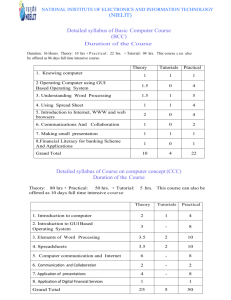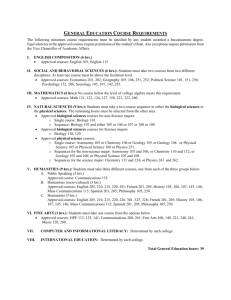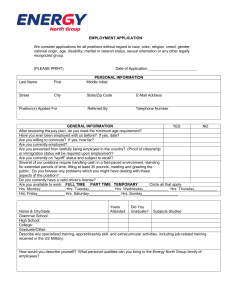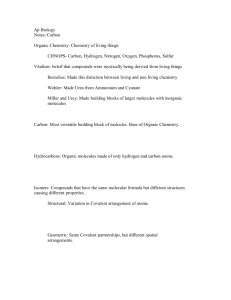V&VI Sem B.Sc. Syllabus Approved and effective from 2012
advertisement
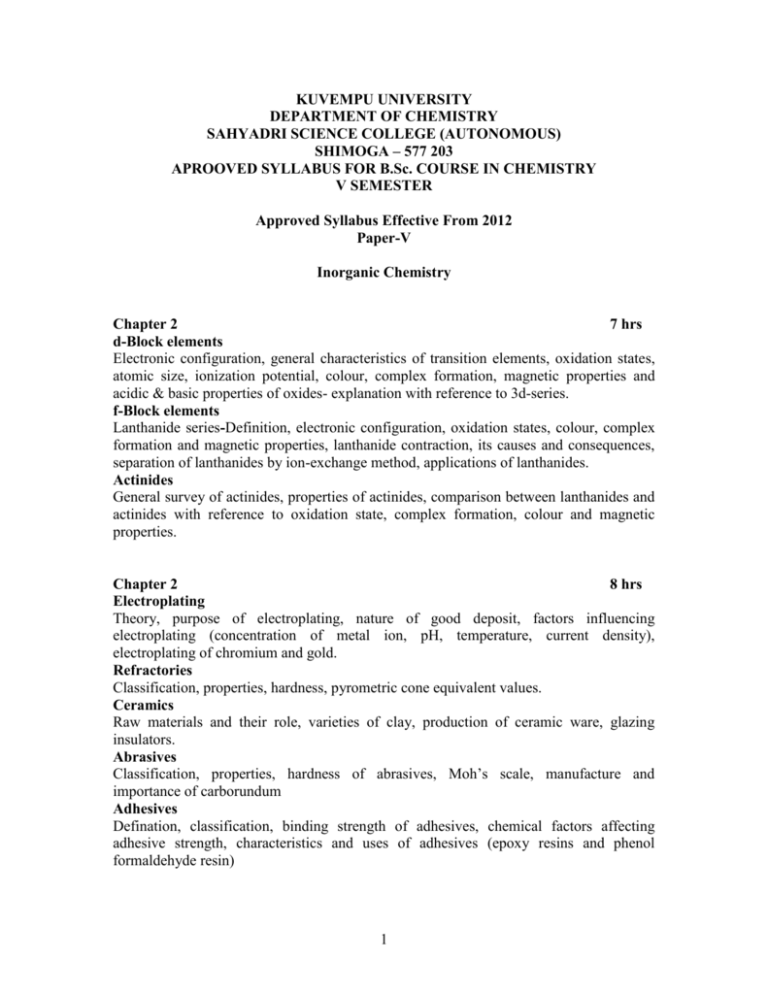
KUVEMPU UNIVERSITY DEPARTMENT OF CHEMISTRY SAHYADRI SCIENCE COLLEGE (AUTONOMOUS) SHIMOGA – 577 203 APROOVED SYLLABUS FOR B.Sc. COURSE IN CHEMISTRY V SEMESTER Approved Syllabus Effective From 2012 Paper-V Inorganic Chemistry Chapter 2 7 hrs d-Block elements Electronic configuration, general characteristics of transition elements, oxidation states, atomic size, ionization potential, colour, complex formation, magnetic properties and acidic & basic properties of oxides- explanation with reference to 3d-series. f-Block elements Lanthanide series-Definition, electronic configuration, oxidation states, colour, complex formation and magnetic properties, lanthanide contraction, its causes and consequences, separation of lanthanides by ion-exchange method, applications of lanthanides. Actinides General survey of actinides, properties of actinides, comparison between lanthanides and actinides with reference to oxidation state, complex formation, colour and magnetic properties. Chapter 2 8 hrs Electroplating Theory, purpose of electroplating, nature of good deposit, factors influencing electroplating (concentration of metal ion, pH, temperature, current density), electroplating of chromium and gold. Refractories Classification, properties, hardness, pyrometric cone equivalent values. Ceramics Raw materials and their role, varieties of clay, production of ceramic ware, glazing insulators. Abrasives Classification, properties, hardness of abrasives, Moh’s scale, manufacture and importance of carborundum Adhesives Defination, classification, binding strength of adhesives, chemical factors affecting adhesive strength, characteristics and uses of adhesives (epoxy resins and phenol formaldehyde resin) 1 Organic Chemistry Chapter 1 Stereochemistry Concept of isomerism, structural isomerism, stereoisomerism and its types. 11 hrs Optical isomerism Elements of symmetry-plane, centric and axis of symmetry conditions for optical activity – van’t Hoff – Lebel hypothesis, enantiomers, and diastereoisomers – Fischer projection formulae, properties and differences, Configuration – D and L-configuration, erythrothreo configuration and R and S-configuration. Optical isomerism of lactic acid and tartaric acid. Racemisation, resolution (mechanical, biochemical, chemical method), Walden inversion, asymmetric synthesis (using optically active reagent) Geometrical isomerism Conditions for the compound to exhibit geometrical isomerism. Nomenclature – cis-trans nomenclature, E-Z nomenclature, syn-anti nomenclature. Determination of configuration of geometrical isomers – physical methods, chemical methods, Beckmann rearrangement-ketoximes. Conformational isomerism Cause for conformational isomerism, conformers, Newmann projection formulae. Conformational isomerism of ethane, 1,2-dichloroethane, cyclohexane-axial and equatorial bonds. Chapter 2 4 hrs Heterocyclic compounds Definition, nomenclature, classification, one method of Synthesis – pyrrole (from acetylene and succinaldehyde), furan, thiophene, pyridine, Chemical properties of pyrrole (Bromination, F C acetylation, nitration, sulphonation, reduction) and pyridine (Bromination, F C acetylation, nitration, sulphonation, reduction, reaction with KOH and NaNH2), Comparison of basicity and aromaticity (MO theory) of pyrrole and pyridine. Physical Chemistry Chapter 1 5 hrs Thermodynamic-II Spontaneous processes, heat engine, Carnot’s cycle and its efficiency, Refrigeration. Concept of entropy. Entropy as a state function, Limitations of First law and need for the second law. Statements of second law of thermodynamics. Entropy changes of an ideal gas with P, V and T. Calculation of entropy changes in different processes (isothermal, adiabatic, isochoric, isobaric and cyclic). Molecular interpretation of entropy, Physical significance of entropy. Entropy changes in phases (problems to be solved). 2 Chapter 2 5 hrs Thermodynamic-III Free energy-Helmholtz free energy(A). Gibb’s free energy(G) and their relationship. Free energy and useful work. Significance of free energy and useful work. Significance of free energy change-criteria for equilibrium and spontaneity. Variation of free energy with P, V, and T. Derivation of Gibbs–Helmholtz equation, Equilibrium constant and its variation with temperature-Vant Hoff’s isotherm, Vant Hoff’s equation, ClausiusClapeyron equation and its applications (problems to be solved). Chapter 3 5 hrs Crystallography Different types of crystals, Laws of crystallography, Elements of symmetry-plane, axes and centre of symmetry. Elements of symmetry in cubic system. Crystal lattice-space lattice and unit cell crystal systems. Bravais lattice, Miller indices, lattice planes in different cubic systems. X-ray diffraction and Bragg’s law(to be derived). Determination of crystal structure of rock salt by Bragg’s method. Avogadro number (Problems to be solved). Approved Syllabus Effective From 2012 Department of Chemistry V SEMESTER Paper-VI INORGANIC CHEMISTRY Chapter 1 6 hrs Inorganic polymers Silicones: Types, preparation (Linear, branched and cyclic), properties and applications. Fluorocarbons: Definition, examples, properties, manufacture of Teflon and uses. Phosphazenes: Preparation, properties and nature of bonding in triphosphazenes. Borazines: Preparation, properties and uses, structure and bonding. S-N ring compounds (S4N4 and S2N2): Preparation, properties and uses. Chapter 2 Advantages of organic reagents in inorganic quantitative analysis Uses of the following organic reagents in inorganic quantitative analysis 1. EDTA – Estimation of hardness of water 2. Oxine – Estimation of Magnesium 3. DMG – Estimation of Nickel 4. 1,10-phenonthraline – Estimation of Iron 3 3 hrs Chapter 3 6 hrs Bio-inorganic Chemistry Elements in biological systems- metals and nonmetals, bulk metals and trace metals. Iron: Co-ordination environment in HEAME, Role of haemoglobin in oxygen transportation. Zinc: Zinc containing metalloenzymes- role of carbonic anhydrase and carboxy peptidase. Magnesium: Co-ordination environment in chlorophyll, skeletal structure of chlorophyll, role of chlorophyll in photosynthesis. Cobalt: Vitamin B12 , Molybdenum: Nitrogenase. Organic Chemistry Chapter 1 9 hrs Carbohydrates Definition, Classification, Constitution of glucose and fructose (open chain and ring structure, determination of ring size), Inter conversions – aldose to ketose and ketose to aldose, chain lengthening and chain shortening of aldoses. Epimerisation - (conversion of glucose to mannose). Mechanism of mutarotation. Disaccharides - Elucidation of structure of maltose and sucrose. Polysaccharides – Structure of starch and cellulose. Chapter 2 3 hrs Alkaloids Definition, classification, method of isolation; elucidation of structure of nicotine and its synthesis by spath process. Chapter 3 3 hrs Terpenes Definition, classification and isolation; isoprene rule, structural elucidation of citral and its synthesis from methyl heptenone. Physical Chemistry Chapter 1 10 hrs Electro Chemistry-I Conductance, specific conductance, molar conductance, equivalent conductance, determination of equivalent conductance, variation of specific and equivalent conductance with dilution. Anomaly of strong electrolytes. Debye – Huckel theory of strong electrolytes - a qualitative treatment. Debye – Huckel – Onsagar equation. Ionic conductivity and ionic mobility. Kohlrausch’s law and its applications (Determination of equivalent conductance of weak electrolyte, determination of solubility and solubility product, and determination of ionic product of water and determination of degree of dissociation). 4 Transport numbers - anomalous transport numbers, principles of determination of transport numbers by Hittorf’s method - both attackable and non-attackable electrodes. Relation between ionic conductance and transport numbers. Principles involved in conductometric titrations of i) strong acid vs strong base ii) weak acid vs strong base iii) strong acid vs weak base iv) weak acid vs weak base v) KCl vs AgNO3. Weston’s standard cell, Nernst reduction equation (to be derived), expression for single electrode potential, reference electrodes - calomel and glass electrodes. Determination of E.M.F. of a cell. Reversible and Irreversible cells. - Energy calculations of a cell and thermodynamic of a chemical cell. Concentration cells - EMF of concentration cell, concentration cells with and without transference. Liquid junction potential and salt bridge. Chapter 2 5 hrs Electro Chemistry-II Applications of EMF measurements 1. Determination of valency of ions. 2. Determination of solubility and solubility product of sparingly soluble salts. 3. Determination of pH of a solution by using i) Quinhydrone and ii) Glass electrode. 4. Potentiometric titrations. i) Acid Base titration ii) Redox titrations. Fuels cells: - Types, their construction and working of H2 –O2 fuel cell. Importance of fuels cells. V SEMESTER PRACTICALS PRACTICAL V 3 hrs per week 01. Estimation of Barium in Barium chloride solution. 02. Estimation of Iron as Iron oxide in Mohr’s salt. 03. Estimation of Aluminium as aluminium oxide in potash alum solution. 04. Estimation of Nickel as Nickel dimethylglyoximate in Nickel ammonium sulphate solution. 05. Estimation of Copper as Cuprous thiocyanate in copper sulphate solution. 06. Estimation of Zinc as Zinc Oxinate in zinc sulphate solution. 07. Estimation of Mg2+ by oxinate method. 08. Estimation of SO42- by gravity method. 09. Seperation of Cu2+, Ni2+ and Fe by paper chromatography-ascending. 10. Separation of amino acids by thin layer chromatography. 5 PRACTICAL VI 3 hrs per week Part A - Estimation 01. Estimation of Glycine 02. Estimation of Citric acid in lemon juice. 03. Estimation of Salicylic acid in Aspirin. 04. Estimation of glucose in urine sample. 05. Estimation of phenol. Part B – Synthesis 01. Preparation of double salt (nickel ammonium sulphate). 02. Preparation of complex compound (copper ammonium sulphate). 03. Preparation of complex compound (potassium trioxalato aluminate). 04. Preparation of organic compounds by a) Oxidation b) Acetylation c) Nitration d) Bromination 6 KUVEMPU UNIVERSITY DEPARTMENT OF CHEMISTRY SAHYADRI SCIENCE COLLEGE (AUTONOMUS) SHIMOGA – 577 203 Approved Syllabus Effective From 2012 Department of Chemistry VI SEMESTER Paper-VII Draft Syllabus Inorganic Chemistry Chapter 1 9 hrs Metallurgy Thermodynamics of metallurgy, Elingham’s diagrams- features, applications and limitations, extraction of lead - self-reduction process and nickel from pentalendite, extraction of manganese from pyrolusite from allumino thermite process extraction of gold by hydrometallurgical process, refining of gold by quartation process, beryllium from beryl via sodium beryllium fluoride, Thorium from Monazite sand and Uranium from Pitch blende by aid digestion process. Chapter 2 6 hrs Alloys Definition, purpose of making alloys, preparation of alloys by electro deposition method and powder metallurgy method, advantages of powder metallurgy, influence of carbon, manganese, nickel, chromium, tungsten, silicon and cobalt on the properties of steel, heat treatment of steel, hardening, tempering and annealing, case hardening of steel-carbiding and nitridins. Ferro alloys- composition and manufacture of ferromanganese and ferrochrome. ORGANIC CHEMISTRY Chapter 1 3 hrs Dyes Definition, classification with examples, Requisites of a dye. Theory of colour and constitution - chromophore-auxochrome theory, modern theory. Synthesis and uses of Congo red, malachite green, indigo. Structural elucidation, synthesis and uses of alizarin. Chapter 2 3 hrs Drugs Definition, Requisites of a drug, chemotherapy, sources of drugs. Sulpha drugs – examples, mode of action, Synthesis and uses of Sulphanilamide, Sulpha thiazole. Antimalarial drugs – Synthesis and uses of chloroquin. Antipyretics – Synthesis and uses of paracetamol, aspirin. 7 Chapter 3 4 hrs Polymers Definition, Types of polymers, stereochemistry of polymers, Addition polymers mechanism of polymerization (ionic and free radical). Synthesis and uses of PVC, polystyrene. Condensation polymers – polyester (Dacron), polyamides (Nylon-6,6). Thermoplastics and thermosetting plastics – phenol formaldehyde resins and urea formaldehyde resins. Natural and synthetic rubber Chapter 4 5 hrs Active methylene compounds Definition, acidity of active methylene compounds. Ethylacetoacetate – Synthesis (Claisen condensation with mechanism), keto-enol tautomerism of Ethylacetoacetate , synthetic applications of ethylacetoacetate – Synthesis of mono and dicarboxylic acids, keto acids, ,-unsaturated acids, amino acids, 4-methyl uracil. Diethyl malonate – Preparation, synthetic applications of diethyl malonate - Synthesis of mono and dicarboxylic acids, keto acids, ,-unsaturated acids, amino acids, barbituric acid. PHYSICAL CHEMISTRY Chapter 1 4 hrs Spectrophotometry Absorption spectra, Laws of absorption of light - Lambert’s law, Beer’s law, Beer-Lambert’s law, Absorption co-efficient , molar absorption co-efficient , molar extinction co-efficient. Construction of Spectrophotometer and determination of absorption band. Uses of Spectrophotometer. (Problems to be solved). Chapter 2 7 hrs Photochemistry Photo physical processes, photochemical processes, photoelectric effect with examples. Laws of photochemistry. (Grothus – Draper law, Einstein’s - Stark law of photochemical equivalence) , quantum yield or efficiency. Reasons for low and high quantum yield with examples. Primary and secondary processes. Mechanism of the following photochemical processes. a) Decomposition of HI b) Combination of H2 and Br2 c) Combination of H2 and Cl2 Problems based on quantum yield (Jablansky’s diagram), Chemiluminescence, bioluminescence, fluorescence, phosphorescence, photo inhibitors, photosensitization, photosynthesis, chemical actinometers (uranyl oxalate actinometer). 8 Chapter 3 4 hrs Radiation chemistry Radiolysis, radiolysis of water vapour. Radiation dosimetry (units). Dosimeters (Fricks dosimeter and ceric sulphate dosimeter). Application to some simple organic and inorganic reactions. (C2H2 , CH4 , C6H6 , HCOOH, CH3COOH) . Lind’s cluster theory, Erying , Hircefelder and Taylor Theory (EHT theory). Difference between photochemistry and Radiation chemistry. Approved Syllabus Effective From 2012 Department of Chemistry VI SEMESTER Paper-VIII INORGANIC CHEMISTRY Chapter 1 12 hrs Co-ordination Chemistry Double salts, complex salts, definition of terms-complex ion, ligand, co-ordination number, co-ordination sphere. Types of ligands with example-monodentate, bidentate, polydentate, Ambidentate and macro cyclic ligands (crown ethers, porphyrins). Methods of detection of complex formation- conductivity, pH, colour. Nomenclature of complex compounds, Isomerism in complex compounds a. Structural isomerism-Ionization isomerism, hydrate isomerism, linkage isomerism and co-ordinate isomerism. b. Optical and geometrical isomerism in complex compounds with co-ordination number 4 and 6. Stability of complex compounds- stability constant, factors influencing the stability of complexes-Nature of metal ion, nature of ligands, chelation and macrocyclic effects. Application of complex formation in (a) Metallurgy (in the extraction of nickel and gold) (b) Qualitative and quantitative analysis. Valance Bond Theory (VBT) Valence bond theory as applied to complexes- inner and outer orbital complexes. The structure and geometry of the following complexes to be discussed: 1. [Fe(CN)6]2- 2. [Fe(H2O)6]2+ 3. [MnCl4]2- 4. [Ni(CO)4]2- 5. [Ni(CN)4]66. [Cu(NH4))4]2+ Modification of VBT : Electroneutrality principle of [Be(H2O)]2+ and back bonding effect with respect to [Ni(CO)4]2-. 9 Crystal Field Theory (CFT) Splitting of d-orbitals in octahedral and tetrahedral fields, effect of weak and strong field ligands, spectrochemical series of ligands, crystal field stabilization energy, calculation of CFSE for different systems. Chapter 2 3 hrs Environmental Chemistry Air pollution - air pollutants - oxides of carbon, nitrogen and sulphur. Global warming, acid rain. Photochemical smog and its effects, depletion of ozone layer-causes and its effect. Water pollution - DO, BOD, COD. ORGANIC CHEMISTRY Chapter 1 6hrs Spectroscopy Electromagnetic radiation, interaction of electromagnetic radiation with organic molecules, Frequency, wavelength, energy of a wave. UV-Visible spectroscopy Range, frequency and energy of UV radiations, interaction of UV radiation with organic molecules, types of transitions, Concept of chromophores and auxochromes, bathochromic shift and hypso chromic shift, hyper chromic effect and hypo chromic effect. Comparison of max of organic compounds taking following examples giving reasons 1. Ethylene and 1,3-butadiene 2. Cis and trans stilbene IR spectroscopy Range, frequency and energy of IR radiations, interaction of IR radiation with organic molecules, molecular vibrations – stretching and bending vibrations, Hook’s law, finger print region, Stretching frequency of functional groups in acetaldehyde, methyleamine, methanol and methylcyanide. Chapter 2 5 hrs Oils, fats and waxes Definition, chemical composition, Chemical properties - hydrogenation, hydrogenolysis, hydrolysis, drying of oils, rancidity, Analysis of oils and fats - saponification value, iodine and acid value, manufacture of soaps - hot process, cleansing action. Synthetic detergents, comparison of soaps and detergents, types of detergents (cationic, anionic and nonionic), animal and plant waxes – Defination, sources and examples. 10 Chapter 3 4 hrs Amino acids and proteins Definition and classification of amino acids, methods of synthesis of α-amino acidsGabriel’s phthalimide, Streckers synthesis. Zwitter ion and isoelectric point, Ninhydrin test. Peptides: peptide bond, carbobenzoxy method of synthesis of peptides Protein: Classification based on composition, structure and function, primary and secondary structures of proteins. Denaturation of proteins, Biuret test. PHYSICAL CHEMISTRY Chapter 1 14 hrs Molecular Spectroscopy Spectrum of electromagnetic radiations, interaction of electro magnetic radiations with molecules, quantisatiation of different forms of energies in molecules. Condition for energy absorption by molecules, emission and absorption spectrum. Spectroscopic terms, classification, Types of molecules - Linear molecules, spherical top molecules, symmetric top molecules, asymmetric top molecules. Rotational Spectroscopy Diatomic molecule as a rigid rotator, model, moment of inertia expression. Rotation energy expression, wave number of rotational spectral line expression (to be derived), Energy level diagram, selection rule for rotational transitions. Determination of moment of inertia and bond length of diatomic molecules (CO, HCl molecules), isotopic effect on the rotational spectra, Intensity of rotational spectral lines. Chapter 2 Rotational - Vibrational Spectroscopy Physical properties and molecular structure 5 hrs Additive properties, constitutive properties, additive - constitutive properties (Molar refraction, refractive index, molar volume - parachor). Polarization Induced polarization, orientation polarization, molar polarization, Classius-Mosotti equation (No derivation) and its importance. Dipole moment Explanation its importance in comparison of bond polarity taking hydracids of halogens. Shape of the molecules a) Tetratomic molecules ex. : PF3 , PCl3 b) Pentatomic molecules ex. : CCl4, SiCl4 c) Differentiating between cis and trans isomers ex. : 1,2 dichloro ethane 11 VI SEMESTER PRACTICALS PRACTICAL VII 3 hrs per week Part-A 01. Determination of percentage composition of a binary mixture of organic liquids by using Abbe’s Refractometer. 02. Determination of rate constant of inversion of cane sugar by Polarimeter. 03. Determination of cell constant (0.1N KCl solution to be prepared by students) and determine the equivalent conductance of the given electrolyte solution by using conductivity bridge. 04. Determination of cell constant (0.1N KCl solution to be supplied) and determine the equivalent conductance at infinite dilution for strong electrolyte of given solution. 05. Potentiometric titration of Mohr’s salt solution vs Potassium dichromate solution 06. Potentiometric titration of Hydrochloric acid vs Sodium hydroxide. Part-B 3 hrs per week 01. Conductometric titration of Sodium hydroxide vs Hydrochloric acid 02. Conductometric titration of Mixture of weak acid and strong acid vs Sodium hydroxide. 03. Determine the pH of mixture of acetic acid and sodium acetate at different concentrations and determination of dissociation constant of acid by using pH meter. 04. Estimation of Cu(II) in the given solution by colorimetric method. 05. Estimation of Fe(III) in the given solution by colorimetric method. 06. Conductometric titration of tertiary mixture of CuSO4 + Acetic acid + HCl using NaOH solution. PRACTICAL VIII 3 hrs per week Project Work / Dissertation 12




